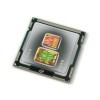- Qualcomm Launches Snapdragon 4 Gen 2 Mobile Platform
- AMD Launches Ryzen PRO 7000 Series Mobile & Desktop Platform
- Intel Launches Sleek Single-Slot Arc Pro A60 Workstation Graphics Card
- NVIDIA Announces Latest Ada Lovelace Additions: GeForce RTX 4060 Ti & RTX 4060
- Maxon Redshift With AMD Radeon GPU Rendering Support Now Available
Intel’s Core i3-530 – The Budget Powerhouse?

When Intel launched its Westmere-based line-up this past January, one of the more interesting models released was the Core i3-530. The big reason was its budget $120 price tag. But if there’s one thing that can make a budget chip interesting, it’s overclocking, and fortunately, there’s huge potential where this chip is concerned.
Page 7 – System: Sandra Memory, Multi-Core Efficiency
Generally speaking, the faster the processor, the higher the system-wide bandwidth and the lower the latency. As is always the case, faster is better when it comes to processors, as we’ll see below. But with Core i7, the game changes up a bit.
Whereas previous memory controllers utilized a dual-channel operation, Intel threw that out the window to introduce triple-channel, which we talked a lot about at August’s IDF. Further, since Intel integrates the IMC onto the die of the new CPUs, benefits are going to be seen all-around.
Before jumping into the results, we already had an idea of what to expect, and just as we did, the results seen are nothing short of staggering.

Thanks to the introduction of an integrated memory controller, the bandwidth seen on all of today’s AMD and Intel CPUs is simply huge. The i3-530 is of course no exception, falling just behind the i5-661, thanks to that chip’s added CPU speed.

As mentioned in our Clarkdale launch article, due to the design of the architecture, memory latency lacks, and it’s easy to see the result of that here. But once again, Intel stresses that the loose latency won’t affect most anyone in the real-world, and I’d have to agree. It sure would have been nice to see latencies more comparable with Lynnfield offerings, though.
Sandra 2009 Multi-Core Efficiency
How fast can one core swap data with another? It might not seem that important, but it definitely is if you are dealing with a true multi-threaded application. The faster data can be swapped around, the faster it’s going to be finished, so overall, inter-core speeds are important in every regard.
Even without looking at the data, we know that Core i7 is going to excel here, for a few different reasons. The main is the fact that this is Intel’s first native Quad-Core. Rather than have two Dual-Core dies placed beside each other, i7 was built to place four cores together, so that in itself improves things. Past that, the ultra-fast QPI bus likely also has something to do with speed increases.

Clarkdale chips might lack where memory latency is concerned, but it sure picks up when talking between the available cores. Neither Intel’s last-gen Core 2’s or AMD’s offerings can hold a candle to the performance from Intel’s latest chips.
Support our efforts! With ad revenue at an all-time low for written websites, we're relying more than ever on reader support to help us continue putting so much effort into this type of content. You can support us by becoming a Patron, or by using our Amazon shopping affiliate links listed through our articles. Thanks for your support!





